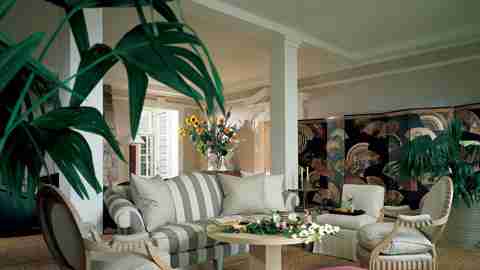View Slideshow

Angelo Donghia enjoyed unprecedented success for an interior designer of the 1970s and 1980s. His private clients included such household names as Ivana and Donald Trump, Barbara Walters, Diana Ross, Mary Tyler Moore, Halston, Ralph Lauren and Neil Simon; his corporate clients were equally impressive. He decorated the Omni International Hotel in Miami, the Hotel InterContinental in New Orleans and PepsiCo's world headquarters in Purchase, New York. Two of his companies produced furniture, textiles and wallcoverings for the design trade, and he licensed his designs for sheets, towels, china, glassware and giftware produced for the general public. Three years before his untimely death in 1985 at the age of fifty, retail sales revenues from the various products that Donghia designed and licensed amounted to a whopping $67.5 million.
Unlike many designers, Donghia had parental approval of his chosen career. When he was a mere eleven years old, his father engaged him to decorate the family tailoring shop in Vandergrift, Pennsylvania. Donghia later recalled philosophically, "The result was perhaps liked by some and hated by others, but that didn't bother me. What mattered was that I had made something which was really the way I saw it and felt it. " With his father's encouragement and assistance, he studied at Parsons School of Design in New York, then joined the design firm headed by Yale R. Burge, with a modest starting salary of seventy-five dollars a week.
His first major success came in 1966. The new Metropolitan Opera House at Lincoln Center was nearing completion, and the Opera Club—a long-established private men's club within the opera house—hired Donghia to design its restaurant and bar. The opening-night premiere of Samuel Barber's Anthony and Cleopatra turned out to be a dud, but at the intermissions the Opera Club's white-tie-and-tailed members and jeweled-and-gowned lady guests were thrilled by the luxurious urbanity of Donghia's interior, with its silver-foil ceiling, blue-glass chandeliers and black-upholstered Regency-style chairs. Several attendees hired Donghia on the spot to design their apartments. Shortly thereafter, Burge made him a partner in the firm, whose name was changed to Burge-Donghia Interiors.
The design team's interiors changed as well, from country French to bold contemporary. Their immediately identifiable features included silver-foil ceilings, lacquered walls, bleached floors and generously proportioned furniture. Donghia's oversize, deeply upholstered sofas and chairs exuded comfort, and they played a leading role in the success of his business. Often they sported massive rolled arms and bun feet and were covered in brightly colored fabrics; some, however, were smartly dressed like young Wall Street stockbrokers, in gray flannel. His novel use of this material—a salute, no doubt, to his family's tailoring business—prompted chilly New York socialites to dub him "the man in the gray flannel sofa. " He answered them by successfully marketing ice buckets dressed in the very same fabric.
Donghia began to diversify in 1968, when the young designer Seymour Avigdor came to him with fabric designs. Recognizing at once that they would be successful, Donghia established a separate company called Vice Versa to manufacture fabrics and wallcoverings from Avigdor's designs for the trade. Later in his life he commented, "Everything I've done has only been driven by one force, and that force was the desire to become better and to become bigger."
After inheriting Burge's design business in 1972, he continued to expand. Over the next several years Donghia opened showrooms in Los Angeles, San Francisco, Chicago, Washington, D.C., Miami and Troy, Michigan, along with a design office in Palm Beach. Yet even as his empire grew, he continued to decorate apartments and houses for celebrities as well as for the merely well-to-do.
Angelo Donghia was an admitted perfectionist. He redecorated his New York town house a number of times, and when he bought a forty-two-acre lakeside retreat in Connecticut, he razed the existing Tudor-style house and built afresh. On the other hand, Donghia preserved an eccentric—and now famous—octagon house in Key West, which he had purchased for forty-five thousand dollars in 1976, decorating it simply with rattan furniture and white canvas coverings. In 1980 he sold it for a reported fifteen times his purchase price of four years before. The "gray flannel" approach had triumphed once again.
